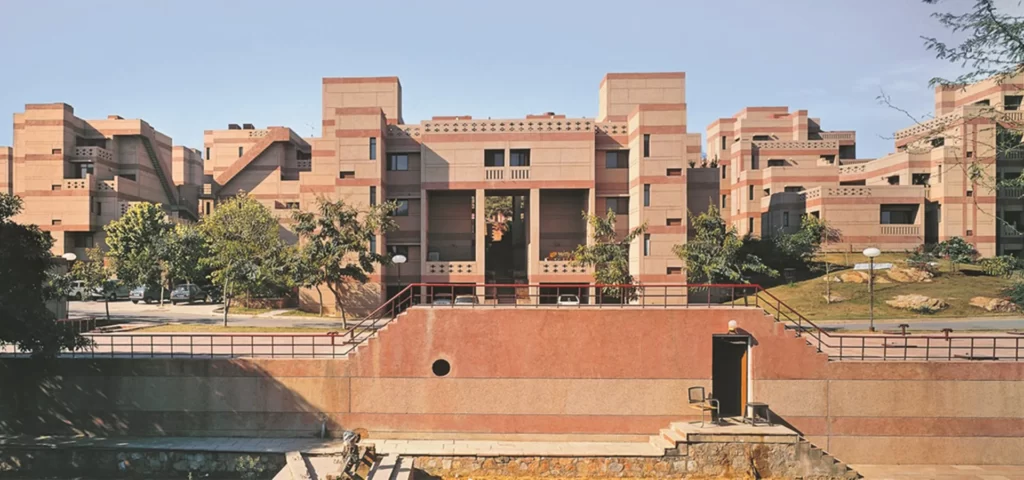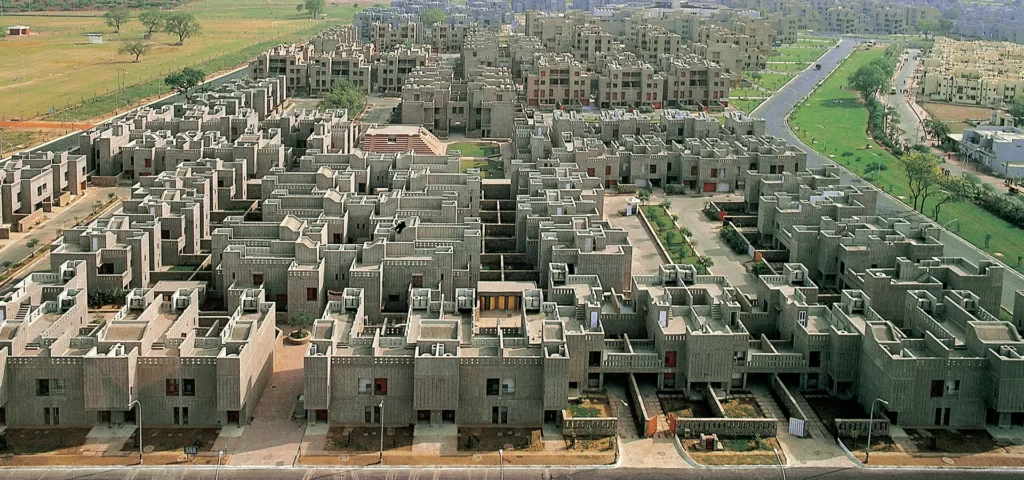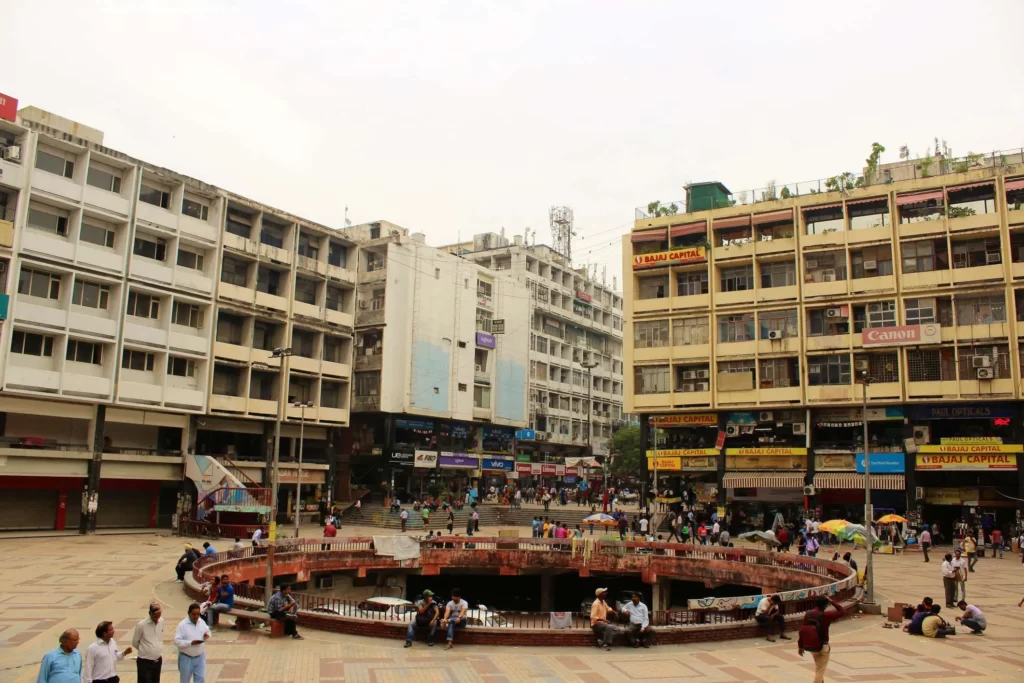If you want to know about the Islamic architecture or staircase design or landscape garden, please click the link.
Introduction
Raj Rewal is a renowned Indian architect who is widely recognized for his innovative and sustainable designs. Born in Haryana in 1934, Rewal studied architecture at the School of Planning and Architecture in Delhi and later pursued his Master’s degree in Architecture at the University of New South Wales in Sydney, Australia.

After returning to India, Rewal established his own architectural firm in Delhi in 1962, where he began designing a wide range of public and private buildings.
Throughout his career, Rewal has emphasized the importance of incorporating traditional Indian design principles and materials into modern architectural forms, as well as the need for sustainable and environmentally conscious design. His work has been widely celebrated and has received numerous awards, both in India and internationally.
1) Early life and education
Raj Rewal was born on August 1, 1934, in Haryana, India. His father, Kewal Krishan Rewal, was a freedom fighter and later served as a member of the Haryana Legislative Assembly. As a child, Raj Rewal was fascinated by art and drawing, and he was encouraged by his parents to pursue his artistic interests.
After completing his schooling, Rewal enrolled in the School of Planning and Architecture in Delhi, where he earned his Bachelor’s degree in Architecture in 1956. During his time at the school, Rewal was deeply influenced by the work of the Swiss-French architect Le Corbusier, who was a leading figure in the modernist movement.
Rewal was particularly drawn to Le Corbusier’s emphasis on functionality, simplicity, and geometric forms, which would go on to influence his own architectural style.
Following his graduation, Rewal began his career working for the Government of India’s Central Public Works Department (CPWD). During his time at the CPWD, Rewal gained valuable experience in designing and overseeing the construction of public buildings, which would prove to be important later in his career.
In 1959, Rewal received a scholarship from the French government to study at the Ecole Nationale des Beaux-Arts in Paris. During his time in France, Rewal was exposed to the work of many of the leading architects of the time, including Le Corbusier, Charles-Edouard Jeanneret (better known as Le Corbusier), and Louis Kahn.
These experiences would further shape Rewal’s approach to architecture and design, and would ultimately lead him to develop his own unique style that combined elements of traditional Indian architecture with modernist principles.
2) Career beginnings
After completing his education and gaining experience working for the Central Public Works Department, Raj Rewal established his own architectural firm in Delhi in 1962. In the early years of his career, Rewal focused on designing a variety of public buildings, including schools, hospitals, and government offices.
One of Rewal’s earliest notable projects was the Nehru Pavilion, which he designed for the 1965 World Trade Fair in New York. The pavilion was a striking example of modernist architecture, featuring a bold geometric design that was inspired by traditional Indian patterns. The pavilion was well-received by critics and helped to establish Rewal’s reputation as an up-and-coming architect.

Another significant project from this period was the LIC Building in Connaught Place, Delhi, which Rewal designed in collaboration with architect Mahendra Raj. Completed in 1986, the LIC Building is a landmark of contemporary Indian architecture, featuring a striking facade that incorporates traditional Indian elements with modernist design principles.
Throughout the 1970s and 1980s, Rewal continued to design a wide variety of public buildings, including the SCOPE Convention Centre in Delhi, the National Institute of Immunology in New Delhi, and the State Trading Corporation Office in Mumbai.
In addition to his architectural work, Rewal was also actively involved in promoting sustainable and environmentally conscious design. He served as a member of the Delhi Urban Arts Commission, where he worked to promote the use of green spaces and sustainable building materials in urban design.
Overall, Raj Rewal’s early work as an architect was marked by a commitment to innovative design and a deep respect for traditional Indian architecture. His early projects helped to establish him as a leading figure in the field of contemporary Indian architecture, and laid the groundwork for his later achievements.
3) Design philosophy and style
Raj Rewal’s approach to architecture is characterized by a deep respect for traditional Indian design principles and a commitment to sustainability and social responsibility. He believes that architecture should be responsive to the social, cultural, and environmental context in which it is built, and should aim to create spaces that are both functional and beautiful.
One of Rewal’s signature design elements is his use of geometric forms and patterns, which are inspired by traditional Indian art and architecture. He often incorporates intricate details and ornamentation into his buildings, using materials such as brick, stone, and concrete to create dynamic facades and interiors.
Another key element of Rewal’s design philosophy is his emphasis on sustainability and energy efficiency. He believes that architects have a responsibility to create buildings that are not only aesthetically pleasing, but also environmentally conscious and socially responsible. To this end, Rewal often incorporates features such as green roofs, passive cooling systems, and natural ventilation into his designs.
Overall, Rewal’s approach to architecture is characterized by a unique blend of modernist principles and traditional Indian design elements. His work emphasizes the importance of context and sustainability in architectural design, and has helped to establish him as one of India’s leading architects.
4) Notable projects
Hall of Nations:
The Hall of Nations was a landmark building in Delhi that was designed by Raj Rewal in collaboration with engineer Mahendra Raj. Completed in 1972, the Hall of Nations was a large exhibition hall that was built to commemorate 25 years of Indian independence.

The building was characterized by its striking design, which featured a series of interconnected domes made of concrete. The domes were arranged in a way that created an open, light-filled interior space that could accommodate a variety of exhibitions and events.
The Hall of Nations quickly became an iconic landmark in Delhi, and was widely celebrated for its innovative design and engineering. However, in 2017, the building was controversially demolished by the Indian government, sparking widespread protests from architects and preservationists who saw the building as an important piece of India’s architectural heritage.
Parliament Library:
The Parliament Library is a notable example of Raj Rewal’s work, completed in 2002. The library is located in the Parliament House complex in New Delhi, and was designed to accommodate the growing needs of the Indian Parliament.

The building features a striking circular design, with a large central courtyard surrounded by a series of stacked, circular floors. The building’s facade is made of red sandstone, which is a nod to the traditional architecture of Delhi.
The Parliament Library has been praised for its innovative design and efficient use of space. The building’s circular design allows for natural light and ventilation to filter throughout the interior, while also creating a sense of openness and community. The library has become an important hub for research and scholarship, and is widely considered to be one of the most important buildings in India.
National Institute of Immunology:
The National Institute of Immunology is a research institution located in New Delhi that was designed by Raj Rewal in 1983. The building features a unique design that is inspired by traditional Indian architecture, with a series of interconnected courtyards and walkways that encourage collaboration and interaction between researchers.

The building’s facade is made of a mix of brick and sandstone, which creates a striking contrast with the lush greenery of the surrounding landscape.
The National Institute of Immunology has been praised for its innovative design and functional layout. The building’s use of courtyards and walkways encourages interaction between researchers and promotes a sense of community and collaboration.
The building has become an important center for research in immunology, and has helped to establish Raj Rewal as one of India’s leading architects.
Asian Games Village:
The Asian Games Village is a housing complex located in New Delhi that was designed by Raj Rewal in 1982.

The complex was built to accommodate athletes participating in the 1982 Asian Games, and features a distinctive design that is inspired by traditional Indian architecture.
The buildings are arranged in a series of clusters, with each cluster featuring a central courtyard and a mix of public and private spaces.
The Asian Games Village has been praised for its innovative design and efficient use of space. The complex has become an important landmark in Delhi, and has helped to establish Raj Rewal as one of India’s leading architects.
Scope Complex:
The Scope Complex is an office complex located in New Delhi that was designed by Raj Rewal in 1989. The complex features a distinctive design that is characterized by its use of a red sandstone facade, which is a nod to the traditional architecture of Delhi.

The buildings are arranged in a series of interconnected blocks, which create a sense of community and encourage interaction between workers.
The Scope Complex has been praised for its innovative design and functional layout. The building’s use of red sandstone creates a striking contrast with the surrounding landscape, and helps to establish the complex as an important landmark in Delhi.
Nehru Place:
Nehru Place is a commercial and business center located in South Delhi that was designed by Raj Rewal in 1986. The center is characterized by its distinctive design, which features a series of interconnected buildings arranged around a central courtyard.

The buildings are made of concrete and feature a distinctive geometric design, which is inspired by traditional Indian art and architecture.
Nehru Place has become an important hub for business and commerce in Delhi, and is widely considered to be one of Raj Rewal’s most important projects. The center has been praised for its innovative design and functional layout, which encourages collaboration and interaction between workers.
Parliament House Annexe:
The Parliament House Annexe is an important government building located in New Delhi that was designed by Raj Rewal in 2001. The building was designed to accommodate the growing needs of the Indian Parliament, and features a distinctive circular design that is inspired by traditional Indian architecture. The building is made of red sandstone and features a series of courtyards and walkways, which create a sense of openness and community.
The Parliament House Annexe has become an important landmark in Delhi, and is widely considered to be one of Raj Rewal’s most important projects. The building has been praised for its innovative design and functional layout, which accommodates the needs of the Indian Parliament while also creating a sense of community and collaboration.
5) Awards and recognition
Raj Rewal has received numerous awards and honors over the course of his career, recognizing his contribution to the field of architecture and his commitment to sustainability and innovation. Some of the most significant awards and honors that he has received are:
- Padma Bhushan: Raj Rewal was awarded the Padma Bhushan, one of India’s highest civilian awards, in 1991 in recognition of his contribution to the field of architecture.
- Aga Khan Award for Architecture: Raj Rewal has been the recipient of multiple Aga Khan Awards for Architecture, one of the most prestigious awards in the field of architecture. He was awarded the award in 1980 for the Hall of Nations in Delhi and in 2016 for the New Campus for the Indian Institute of Technology in Delhi.
- Global Award for Sustainable Architecture: In 2019, Raj Rewal was awarded the Global Award for Sustainable Architecture, recognizing his contribution to sustainable design and architecture.
- Doctor of Letters (Honoris Causa): Raj Rewal has been awarded multiple honorary doctorates from universities across India, including a Doctor of Letters (Honoris Causa) from the University of Delhi in 2019.
- Indian Institute of Architects Gold Medal: Raj Rewal was awarded the Indian Institute of Architects Gold Medal in 1993 in recognition of his contribution to the field of architecture.
These awards and honors are significant because they recognize Raj Rewal’s contribution to the field of architecture and his commitment to sustainability and innovation. They also highlight the importance of his work in shaping the built environment of India and the world.
6) Legacy and influence
Raj Rewal has had a significant impact on the field of architecture, both in India and internationally. His innovative and sustainable designs, as well as his commitment to blending traditional and modern elements, have influenced many architects and designers.
One of the most significant impacts that Raj Rewal has had on the field of architecture is his commitment to sustainability. Throughout his career, he has advocated for sustainable design and has incorporated sustainable features into his projects. His designs often incorporate elements such as natural ventilation, passive cooling, and rainwater harvesting. This has helped to set a standard for sustainable design in India and beyond.
Another important impact that Rewal has had on the field of architecture is his ability to seamlessly blend traditional and modern elements in his designs. His buildings often incorporate traditional Indian architectural elements such as arches and domes, but are also modern and innovative. This has helped to create a unique architectural style that is both rooted in tradition and forward-looking.
Rewal’s work has also influenced other architects and designers, both in India and internationally. His approach to sustainable design and his ability to blend traditional and modern elements have inspired many architects to incorporate similar features into their own designs. In addition, his projects have helped to shape the built environment of India, and his innovative designs have become important landmarks in many cities across the country.
Overall, Raj Rewal’s impact on the field of architecture has been significant, and his work continues to inspire and influence architects and designers around the world.
7) Conclusion
Raj Rewal is an Indian architect who is known for his innovative and sustainable designs. He was born in 1934 in Punjab, India and received his education in architecture from the School of Planning and Architecture in Delhi. Rewal’s early work as an architect included designing housing complexes and public buildings, and he gained recognition for his work on the Hall of Nations in Delhi, which was built in 1972.
Rewal’s approach to architecture is rooted in a philosophy of sustainability and a desire to blend traditional and modern elements. His signature style includes the use of geometric shapes, natural ventilation, and a focus on energy efficiency. Some of his most famous projects include the Parliament Library in New Delhi and the Hall of Nations in Delhi.
Rewal has received numerous awards and honors throughout his career, including the Padma Bhushan, the Aga Khan Award for Architecture, the Global Award for Sustainable Architecture, and the Indian Institute of Architects Gold Medal. His work has had a significant impact on the field of architecture, particularly in India, and he has inspired many architects and designers to incorporate sustainable design principles into their own work.
In summary, Raj Rewal’s contributions to architecture and design are significant and have helped to shape the built environment of India and beyond. His innovative and sustainable designs, as well as his commitment to blending traditional and modern elements, have influenced many architects and designers, and his impact on the field of architecture continues to be felt today.